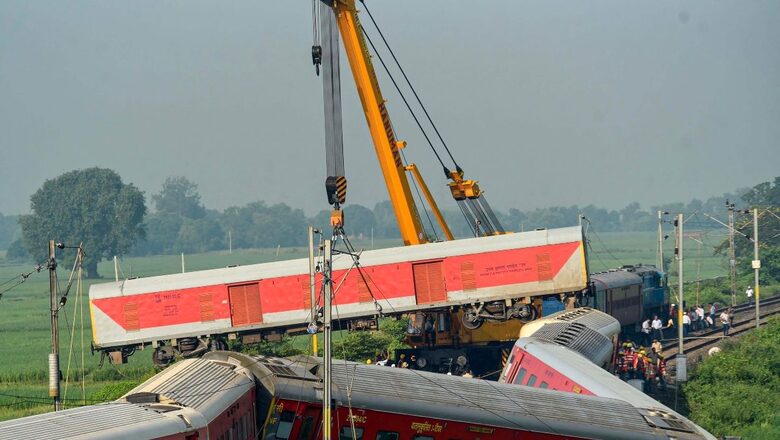
views
The ubiquitous railway accident has happened once again. This time, it has happened in Bihar, my native state and the Danapur Division of Indian Railways (IR) notorious for the worst type of “chalta hai” attitude when it comes to the maintenance of railway assets. What I say, I say with the utmost responsibility and firm conviction, because I belong to the place where the accident happened and have dirtied my hands working in the Danapur Division of East Central Railway for more than two years. I have personally handled the aftermath of Indian Railways’ worst fire accident in Patna on May 16, 1990, in which 74 were roasted alive and 400 sustained severe burn injuries.
The Accident
It is reported that the accident happened at 9.40 pm, near the nondescript mufassil town Raghunathpur of the ancient Buxar district in Bihar. It transpires that 23 coaches of Assam-bound Delhi-Kamakhya North East Express derailed, with four coaches mangled, leaving at least four passengers travelling in AC coach dead and 50-100 injured, out of which more than a dozen seriously so. The travesty of India has been that the dataset of the actual number of injured in a railway accident has always been inexact, though in this case, it is not likely to be much different than reported.
Money no Compensation for the Loss of Life
Having lost my younger sister on November 20, 2016, in the Indore–Patna Express accident, near Pukhrayan, Kanpur (at least 150 died and more than 150 injured), I dare say that money is no compensation for the loss of life. I have my own exacting standards and in the case of avoidable railway accidents, I consider IR senior management of the zone guilty of culpable homicide not amounting to murder under Section 304 of the Indian Penal Code and liable for imprisonment for life or imprisonment for up to 10 years and a fine. I am of the firm opinion that instead of fixing responsibility on the lowest ranked officials, let one DRM (if not GM) get exemplary punishment for an avoidable accident and such accidents will vanish altogether from the Indian Railways system.
It is about time we stop playing the game of passing the buck.
Nonetheless, for whatever is it worth, ex-gratia of Rs 10,00,000 has been announced to the next of kin and Rs 50,000 to the injured. Locals reached the accident site first, district officials next and the railways team last. True to his nature, the Railways Minister Ashwini Vaishnaw has walked the talk and reached the site within hours to inspect, monitor and expedite the rescue and restoration and Bihar Chief Minister Nitish Kumar, an ex-Railway Minister himself, has assured full assistance of the state.
So far so good.
Soon, the debris of the derailed coaches will be removed, the track will be cleared and restored, and railways will chug along, till another accident happens. This has become the destiny of Indian Railways.
There is God, He is Indian and this Time Bihari
It is reported that the driver of the North East Express anticipated some trouble applying the emergency brake when the train was travelling at a speed of 128 kmph and the severity of the accident can be ascertained by what impact it had on the guard of the train in the rear end. Here is what the guard of the Kamakhya-bound train, Vijay Kumar said: “I was busy with my paperwork when I realised that the driver suddenly applied brakes. This was followed by a few jerks, and I fainted. Later, I found myself in the adjoining fields, where villagers were sprinkling drops of water on my face.” (Source: PTI)
Kumar was lucky to escape with minor injuries while passengers of the AC coach were not. It was a major accident with a relatively lesser casualty.
The train was travelling at the maximum permissible speed, its 23 coaches derailed, four of its AC coaches (fortunately not ordinary second-class coaches) got mangled but only four died and barely a dozen got injured seriously. The low casualty could have been due to the safer anti-telescopic Linke Hofmann Busch (LHB) coaches which do not go turtle, luck by chance, sheer destiny or the divine intervention of Lord Rama whose karmabhoomi has been Buxar.
Causes of the Accident
Ashwini Vaishnaw posted on X (formerly known as Twitter), “Will find the root cause of derailment.” I wish he does and does it soon and takes guilty to the gallows, figuratively, if not literally.
The preliminary inquiry into the accident puts the needle of suspicion on possible issues with the track because the engine driver applied emergency brakes after sensing a “rattling” on the tracks. Though the real reason of the accident is yet to be ascertained, it is in the realm of the possibility that the alert driver with his foresight and quick reflexes might have avoided a more serious disaster.
High-Level Enquiry
Nonetheless, as it happens with every consequential railway accident that involves the loss of a human life, a high-level enquiry by the Commissioner of Rail Safety (CRS) has been announced. CRS is expected to delineate the root cause of the accident. And as is the usual fate of the CRS enquiry reports, the findings will be either accepted or not accepted by the Railway Board, but the CRS report will never be officially made available to public scrutiny, though convenient snippets will get leaked.
Time for An Empowered Independent Rail Safety Authority
In February 2012, the report of the High-Powered Safety Committee on Indian Railways, headed by the noted scientist Dr Anil Kakodkar, in its executive summary had the following to say: “There is no practice of independent safety regulation by an independent agency separate from operations. The Railway Board has the unique distinction of being the rule maker, operator and regulator, all wrapped into one. Commissioners of Railway Safety though considered to be the safety watchdogs have negligible role at the operational level. Compliance of safety standards set by Railways for themselves are often flouted for operational exigencies. The Committee has recommended a statutory Railway Safety Authority (RSA) and a safety architecture which is powerful enough to have a safety oversight on the operational mode of Indian Railways without detaching safety with the railway operations. The Committee has also recommended measures to strengthen the present Railway Safety Commission to undertake meaningful regulatory inspections.”
More than a decade has gone by, but the above salutary recommendation of Dr Anil Kakodkar’s Committee is yet to be implemented by the Railway Board, proving the ultimate observation of the committee’s holy grain of truth — Indian Railways suffers from the implementation bug.
Brief History of the Recommendation
There is a history behind the above recommendation. E. Sreedharan, former managing director of Delhi Metro Rail Corporation (DMRC) and previous Member of the Engineering Railway Board was the official Advisor to the Kakodkar Committee, and yours truly, then Advisor of Strategic Planning to DMRC was the exclusive assistant and researcher on the matter to E. Sreedharan. The above recommendations were in reality written by me under the guidance of and with the approval of E. Sreedharan. I had two reasons to write what I wrote-
One, the type of safety architecture in the form of an independent Rail Safety Authority was recommended after best practices research and the model recommended was in existence in the UK with the name ‘Rail Safety and Standards Board’ and was immensely successful.
Two, as a resident of Bihar and IR insider having worked in railways in Bihar, I was privy to the deadliest railway accident in Bihar that happened on June 6, 1981, when a passenger train carrying more than 800 passengers between Mansi (Dhamara Pul) and Saharsa, derailed and plunged into the river Bagmati while it was crossing a bridge. The estimated death toll was between 500 to 800 though the railway stayed put with the official toll of 235 dead with 88 survivors. To date, one is not sure of the causes, though the widely talked about are cyclones or flash floods. The Commissioner Railway Safety report was never made public. Even today, a Google search “Railway Board Makes Public the Report of Commissioner Rail Safety on Baghmati Rail Accident” draws a blank result.
Consequential Accidents Reduce, IR Continues to Kill
During the last five years, consequential accidents in railways have gone down exemplifying a relatively better safety record. But thousands of innocent citizens and even railway employees, even now, die annually on railway tracks. It is time that I verbatim quote from the Kakodkar Committee because the situation has not substantially improved on the ground since 2012.
One, casualties of Railways’ own staff while on duty were collected from Zonal Railways and the position is markedly high. About 1600 railway staff were killed and 8700 injured while working during the period from 2007-08 to October 2011 which is substantially more than 1019 deaths and 2118 injuries in train accidents for the period from 2007-08 to 2010-11.
Two, apart from the casualties due to consequential accidents, the Committee was informed that a large number of casualties take place over the entire railway system due to unlawful trespassing, though the exact figures have not been compiled by the Railways nor are readily available. The estimation is almost 15000 persons get killed on the entire railway system every year, of which, about 6000 deaths are only on the Mumbai Suburban System. The reluctance of Indian Railways to own these casualties, which do not fall under the purview of train accidents but are nevertheless accidents on account of trains, can by no means be ignored. No civilized society can accept such massacre on their railway system. (para 2.15.2 page 35 of the report).
The Wake-Up Call
Any major accident with minor casualty like the one at Buxar or even a near miss without actual casualty, must be a wakeup call for the Railway Board bosses, who must get to the root cause analysis, reaffirm zero tolerance for incidents, take exemplary action to punish those found guilty and ensure that the accident of the type is never repeated. And the Railway Board should get out of its track record of fixing responsibility always at the lowest possible level of officials.
An Appeal to Jaya Varma Sinha, CEO of Indian Railways
The Buxar accident is the first major accident in the tenure of Jaya Varma Sinha, the new Chairperson of the Railway Board. Instead of looking at Jaya as the first IR woman CEO, I have always admired her as one of the most competent, and urge her to take a vow to totally eliminate avoidable accidents from IR. It is possible.
If India can land on the Moon with laser-focused attention to detail, it can also eliminate railway accidents. What is needed is the will and courage to take resolute, bold decisions and decisive actions and eliminate the curse thy name is avoidable railway accidents in India.
Akhileshwar Sahay is a Multidisciplinary Thought Leader with Action Bias and India-Based International Impact Consultant. An acknowledged railway expert, he is an ex-Indian Railway Officer. During 2014-2015, he was co-opted by the Railway Board to the One-Man E. Sreedharan Committee. He works as President Advisory Services of Consulting Company, BARSYL. Views expressed in the above piece are personal and solely that of the author. They do not necessarily reflect News18’s views.



















Comments
0 comment